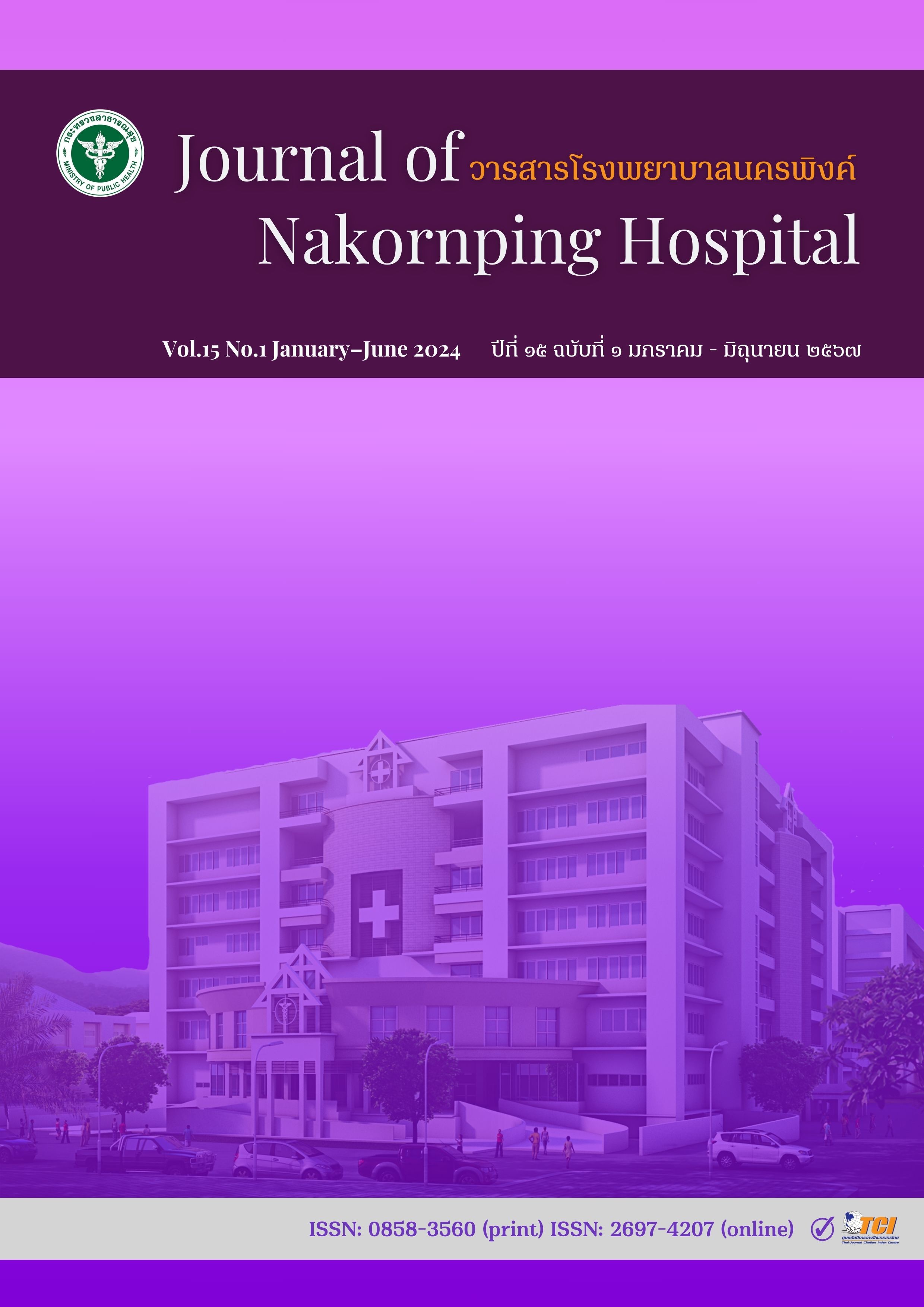การเปรียบเทียบผลลัพธ์ทางคลินิกระหว่างการได้รับ surfactant ด้วยวิธี INSURE กับวิธี conventional ในทารกน้ำหนักแรกเกิดน้อยกว่า 1500 กรัม ที่มีภาวะ respiratory distress syndrome ในโรงพยาบาลนครพิงค์
คำสำคัญ:
RDS, BPD, surfactant, INSURE, ทารกน้ำหนักน้อยมากบทคัดย่อ
บทนำ: การให้ surfactant ในทารกเกิดก่อนกำหนดที่มีภาวะ Respiratory distress syndrome (RDS) ด้วยวิธี INSURE มีข้อดีกว่าวิธีเดิม (conventional) แต่ทางปฏิบัติยังมีขีดจำกัดของบุคลากรและทรัพยากร
วัตถุประสงค์: เพื่อเปรียบเทียบผลลัพธ์ทางคลินิกระหว่างทารกเกิดก่อนกำหนดน้ำหนักน้อยกว่า 1,500 กรัม ที่มีปัญหา RDS ที่ได้รับ surfactant ด้วยวิธี INSURE เทียบกับวิธี conventional และศึกษาความสำเร็จในการถอดท่อช่วยหายใจหลังการให้ surfactant ด้วยวิธี INSURE
วิธีการวิจัย: การศึกษาย้อนหลัง โดยการทบทวนเวชระเบียนของทารกเกิดก่อนกำหนดน้ำหนักน้อยกว่า 1,500 กรัม ที่มีปัญหา RDS และได้รับ surfactant ตั้งแต่ 1 ตุลาคม 2562 ถึง 30 กันยายน 2565 วิเคราะห์ผลลัพธ์ระหว่างการได้รับ surfactant โดยใช้สถิติ Guassian regression model หรือ Logistic regression model ตามลักษณะข้อมูล และวิเคราะห์ ปรับด้วย inverse propensity score weighting
ผลการวิจัย: ทารกที่เข้าเกณฑ์ศึกษา 280 ราย มีภาวะ RDS 240 ราย และได้รับ surfactant 194 ราย (ร้อยละ 80.8) โดยได้รับวิธี conventional และวิธี INSURE 157 ราย (ร้อยละ 80.9) และ 37 ราย (ร้อยละ 19.1) ตามลำดับ พบว่าทั้งสองกลุ่ม มีเพศ วิธีการคลอด อายุของมารดา การได้รับ intrapartum antibiotic prophylaxis และ ภาวะแทรกซ้อนระหว่างการคลอดไม่แตกต่างกัน แต่มีน้ำหนักแรกเกิด อายุครรภ์ อัตราการเกิดในโรงพยาบาล Apgar score ภาวะ pregnancy induce hypertension ของมารดา และการได้รับ antenatal steroid น้อยกว่าในกลุ่ม conventional และเมื่อปรับด้วย inverse propensity weighting แล้ว พบว่ากลุ่ม INSURE มี severe BPD หรือเสียชีวิตน้อยกว่า (OR 0.39, 95% CI 0.16-0.96, p = 0.041) อัตราการเกิด Ventilator associated pneumonia น้อยกว่า (OR 0.26, 95% CI 0.07 – 0.94, p = 0.041) และอัตราการเกิด retinopathy of prematurity ตั้งแต่ stage 3 ขึ้นไป น้อยกว่า (OR 0.10, 95% CI 0.06 – 0.18, p <0.001) เมื่อเทียบกับกลุ่ม conventional อย่างมีนัยสำคัญทางสถิติ และ ตามลำดับ กลุ่ม INSURE ถอดท่อช่วยหายใจสำเร็จหลังได้ surfactant 29 ราย (ร้อยละ 78.4) โดยกลุ่มทารกน้ำหนักน้อยกว่า 1000 กรัม มีอัตราการถอดท่อช่วยหายใจสำเร็จ ร้อยละ 71.4 ในกลุ่มถอดท่อไม่สำเร็จ พบภาวะ patent ductus arteriosus (ร้อยละ 100, p=0.006) สูงกว่า กลุ่มถอดทอสำเร็จ (ร้อยละ 44.8)
สรุป การให้ surfactant ด้วยวิธี INSURE ในบริบทของโรงพยาบาลรัฐระดับตติยภูมิ ให้ผลลัพธ์ที่ดีแก่ทารกแรกเกิดที่มีน้ำหนักน้อยมาก ลดภาวะแทรกซ้อนที่สำคัญ เห็นควรพัฒนาต่อเพื่อให้เข้าถึงได้มากขึ้น
References
Lagoski M, Hamvas A, Wambach JA. Respiratory distress syndrome in the neonate. In: Martin RJ, Fanaroff AA, Walsh MC, editors. Fanaroff and Martin's Neonatal-Perinatal Medicine : Diseases of the Fetus and Infant. 11th ed. Philadelphia, PA :Elsevier/Saunders; 2020. p. 1159-73.
Pirunnet T. Update in RDS Management. In: Punnahitanon S, editor. Smart practice in neonatal care. Bangkok: Thai Neonatal Society; 2019. P.285-325. [In Thai]
Sweet DG, Carnielli V, Greisen G, Hallman M, Ozek E, te Pas A, et al. European consensus guidelines on the management of respiratory distress syndrome – 2019 update. Neonatology. 2019;115(4):432-50. doi: 10.1159/000499361.
Escobedo MB, Gunkel JH, Kennedy KA, Shattuck KE, Sánchez PJ, Seidner S, et al. Early surfactant for neonates with mild to moderate respiratory distress syndrome: A multicenter, randomized trial. J Pediatr. 2004;144(6):804-8. doi: 10.1016/j.jpeds.2004.03.024.
Tapia JL, Urzua S, Bancalari A, Meritano J, Torres G, Fabres J, et al. Randomized trial of early bubble continuous positive airway pressure for very low birth weight infants. J Pediatr. 2012;161(1):75-80. doi: 10.1016/j.jpeds.2011.12.054.
Dani C, Corsini I, Poggi C. Risk factors for intubation-surfactant-extubation (INSURE) failure and multiple INSURE strategy in preterm infants. Early Hum Dev. 2012;88(Suppl 1):S3-4. doi: 10.1016/j.earlhumdev.2011.12.019.
Stevens TP, Blennow M, Soll RF. Early surfactant administration with brief ventilation vs selective surfactant and continued mechanical ventilation for preterm infants with or at risk for RDS. Cochrane Database Syst Rev. 2002;(2):CD003063. doi: 10.1002/14651858.CD003063.
Rojas MA, Lozano JM, Rojas MX, Laughon M, Bose CL, Rondon MA, et al. Very early surfactant without mandatory ventilation in premature infants treated with early continuous positive airway pressure: a randomized, controlled trial. Pediatrics. 2009;123(1):137-42. doi: 10.1542/peds.2007-3501.
Berlin SC. Diagnostic Imaging of the Neonate. In: Martin RJ, Fanaroff AA, Walsh MC, editors. Fanaroff and Martin's Neonatal-Perinatal Medicine : Diseases of the Fetus and Infant. 11th ed. Philadelphia, PA: Elsevier/Saunders; 2020. p. 608-633.
Awaysheh F, Alhmaiedeen N, Al-Ghananim R, Bsharat A, Al-Hasan M. Criteria for Using INSURE in Management of Premature Babies with Respiratory Distress Syndrome. Med Arch. 2019;73(4):240-43. doi: 10.5455/medarh.2019.73.240-243.
Jobe AH, Bancalari E. Bronchopulmonary dysplasia. Am J Respir Crit Care Med. 2001;163(7):1723-9. doi: 10.1164/ajrccm.163.7.2011060.
Higgins RD, Jobe AH, Koso-Thomas M, Bancalari E, Viscardi RM, Hartert TV, et al. Bronchopulmonary Dysplasia: Executive Summary of a Workshop. J Pediatr. 2018;197:300-8. doi: 10.1016/j.jpeds.2018.01.043.
Ruangphraya T, Jenjarat K. Outcomes of very low birth weight preterm infants at Nakornping hospital. Journal of Nakornping Hospital. 2021;12(2);32-49. [In Thai]
Tanthawat S. Outcome of very low birth weight infants in Udonthani Hospital. Udonthani Hospital Medical Journal. 2017;25(3);241-48. [In Thai]
Prepruettrong A. Neonatal outcome between INSURE method and conventional method in preterm infants with respiratory distress syndrome. Academic Journal of Mahasarakham Provincial Public Health Office. 2020;4(8);177-87. [In Thai]
Wisetwoharn P, Aswakul O. Respiratory distress in early premature newborns with suboptimal antenatal steroid. Thai Journal of Obstetrics and Gynaecology. 2019;27(4);195-202. [In Thai]
Prempunpong C. Thai Newborn Registry (ThaiNY). In: Punnahitanon S, editor. Practice updates in neonatology. Bangkok: Thai Neonatal Society: 2023. p. 1-4. [In Thai]
Morley CJ, Davis PG, Doyle LW, Brion LP, Hascoet JM, Carlin JB; COIN Trial Investigators. Nasal CPAP or intubation at birth for very preterm infants. N Engl J Med. 2008;358(7):700-8. doi: 10.1056/NEJMoa072788.
Benitz WE, Bhombal S. Patent ductus arteriosus in the neonate. In: Martin RJ, Fanaroff AA, Walsh MC, editors. Fanaroff and Martin's Neonatal-Perinatal Medicine : Diseases of the Fetus and Infant. 11th ed. Philadelphia, PA :Elsevier/Saunders; 2020. p. 1334-41.
Read B, Lee DS, Fraser D. Evaluation of a practice guideline for the management of respiratory distress syndrome in preterm infants: A quality improvement initiative. Paediatr Child Health. 2016;21(1):e4-9.
Brix N, Sellmer A, Jensen MS, Pedersen LV, Henriksen TB. Predictors for an unsuccessful INtubation-SURfactant-Extubation procedure: a cohort study. BMC Pediatr. 2014;14:155. doi: 10.1186/1471-2431-14-155.
Downloads
เผยแพร่แล้ว
How to Cite
ฉบับ
บท
License
Copyright (c) 2024 โรงพยาบาลนครพิงค์

This work is licensed under a Creative Commons Attribution-NonCommercial-NoDerivatives 4.0 International License.
บทความที่ได้รับการตีพิมพ์เป็นลิขสิทธิ์ของโรงพยาบาลนครพิงค์ จ.เชียงใหม่
ข้อความที่ปรากฏในบทความแต่ละเรื่องบทความในวารสารวิชาการและวิจัยเล่มนี้เป็นความคิดเห็นส่วนตัวของผู้เขียนแต่ละท่านไม่เกี่ยวข้องกับโรงพยาบาลนครพิงค์ และบุคลากรท่านอื่นๆในโรงพยาบาลฯ ความรับผิดชอบเกี่ยวกับบทความแต่ละเรื่องผู้เขียนจะรับผิดชอบของตนเองแต่ละท่าน



